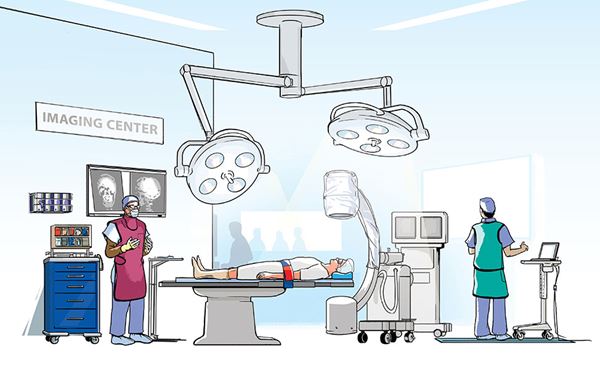-
Home
-
Protecting Yourself from Risks Associated with Scatter Radiation Exposure
Protecting Yourself from Risks Associated with Scatter Radiation Exposure
March 13, 2020

Radiation—it can be a big and often frightening word with serious implications. No magnitude of radiation exposure is known to be completely safe, and multiple health problems are associated with it, making risk reduction critical for both patient and staff safety.
As the number of interventional procedures increases due to advances in both technology and clinical efficacy,1 clinical staff will continue to be exposed to scatter radiation, which accounts for a greater portion of exposure than the primary X-ray beam.
How are You Exposed to Scatter Radiation?
When the source of radiation is below a patient without any rotation, most of the exposure comes through backscatter below the table, which impacts the clinician’s lower extremities.1
However, if the X-ray tube is rotated with the beam projected away, radiation will effectively bounce back on the clinician, putting more radiosensitive organs such as the eyes, thyroid, and breast at risk.1
This scatter radiation can lead to a variety of lasting effects.
What Biologic Effects Exist?
Though lasting adverse effects and the biologic consequences of cumulative exposure still aren’t clear, these biologic effects can be split into two main categories—nonstochastic (deterministic) and stochastic.1
Essentially, deterministic effects occur at a threshold, after which the severity of the injury can worsen with more exposure. Think cataracts or erythema. On the other hand, the severity of stochastic effects (for example, cancer) isn’t determined by a threshold or dosage.
Interventional clinicians are at risk for both deterministic and stochastic effects.
How Can You Reduce Your Risk?
Before preventative measures can even be considered, proper training must be employed to help clinicians reduce their risk, as many expose themselves to radiation more often than necessary through imperfect practices or a lack of awareness.
Though fluoroscopy is a necessary part of modern medical care, simple methods can have a large impact on the reduction of radiation exposure. It’s critical to consider how long you are exposed, how far away you are from the radiation, and what you can employ to shield yourself. In fact, shielding is the most important factor and taking consistent and appropriate measures such as wearing personal protective apparel can help reduce exposure risk.2
Types of Personal Protective Apparel
The most recognizable personal protective apparel is the radiation protection apron, which provides the same level of protection as lead and should be worn properly fitted at the neckline and armholes.2
Though protective aprons are important, they should be augmented by the use of other wearables such as thyroid shields and radiation protection glasses, which provide critical protection for the sensitive thyroid and eyes. Radiation attenuation gloves, which are often overlooked, are equally as important to protect hands from scatter radiation while offering dexterity and tactile sensitivity during procedures, making them an important part of protecting yourself from the lasting consequences of radiation exposure.
As fluoroscopy continues to be an important part of interventional procedures and those procedures continue to increase in number, protecting yourself from radiation is key. With over five decades of experience, AliMed can help you find all the radiation protection products you need to take care of both your patients and yourself.
Learn more about AliMed’s full line of radiation protection products.
Resources:
- https://www.asra.com/asra-news/article/160/radiation-safety-for-the-chronic-pain-ph
- https://www.ncbi.nlm.nih.gov/pmc/articles/PMC6177538/